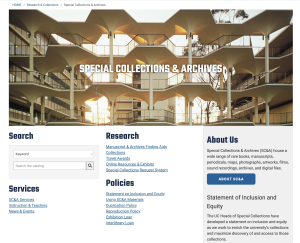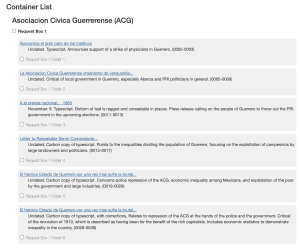Finding a Library’s Special Collections
Where to Start
Special collections are not as easy to find as other library materials we’ve discussed so far. If you were looking for a specific book or journal article, many libraries would have these same materials, and you could search for them in a library’s catalog or discovery service. However, special collections often contain materials that are more unique and sometimes the only available item in the world.
You can often learn about what is available by looking at a university library’s website for a department called “Special Collections & Archives” or something similar. As an example, below is the homepage for UC San Diego’s Special Collections & Archives department.

While there is a search function on this page with search capabilities, this isn’t where you typically search for special collections materials; rather, this just searches the library’s discovery service. However, you could do a keyword search in this search bar and then limit the library filter to “Special Collections & Archives.” While you might find some results relevant to your keywords, there is another way to search for special collections materials.
Finding Aids
Rather than turn to the search function, you’ll see a link to “Manuscript & Archives Finding Aids.” There is a search function on this page to search within all of the library’s finding aids, as well as the ability to browse by collection title or by subject. For now, I’m going to just browse “Mexico Manuscript Collections.” Looking through the collections listed here, I think I’ll look at the “Armed Revolutionary Organizations in Mexico Documents, 1965-1998 (MSS 523).” The link to the catalog record, takes us to the discovery service record. The record shows us the title, a brief description, a creation date, and some other important bibliographic information. This record is no doubt helpful, but let’s now look at the finding aid.
Finding aids describe a collection in a much more robust way than catalog records. The finding aid not only helps users navigate the contents of the collection and identify potential materials to use in their own research but also includes the history of the collection and how the items are arranged.
Finding aids are also created for a collection and may or may not tell you what individual items are in the collection. We got lucky with the collection we chose because the finding aid provides us with the full inventory of the items available. The “Scope and Content of Collection” provides us with information about the collection as a whole and more detailed descriptions about its 23 series.
Accessing Special Collections Materials
At the bottom of the finding aid is the container list where you can see the individual items within a series. These materials are physically housed in archival boxes which contain several folders, so you should note that each item states where it is physically located, such as Box 1, Folder 4.

I decide that the Asociacion Civica Guerrerense (ACG) [sic][1] materials are of most interest to my research. In this example, I have the ability to request various boxes or folders that I feel may be most pertinent to my research. I inform the library of what I want to research and provide a date that I’ll be coming in, and the archivist or librarian will pull these materials out for me, which I will be able to look at in their reading room.
Special Rules in Special Collections
Visiting special collections can be a bit intimidating because of all of the rules in place! Just remember that these materials are often rare, fragile, or unique, so there are rules in place to ensure their integrity and longevity. Some common rules include:
- Provide photographic ID and
- No large bags or backpacks (there may be a locker available)
- No ink pens, but you can use pencils, laptops, and tablets
- Minors either not allowed or must be accompanied by an adult
- Duplication requests might need to be approved by an archivist or librarian, or you may be allowed to take photos with your phone or a camera
And, while not a rule, keep in mind that preservation of special collections materials requires rather cool temperatures: bring a jacket or something warm.
Sources
“What is a Finding Aid?” YouTube, uploaded by CU Boulder Libraries, 29 April 2021.
- The organization is named "La Asociación Cívica Guerrerense." The lack of accents is a spelling error. Finding aids are created by archivists, who may not have the knowledge–in this case, of the Spanish language–to appropriately describe collections. ↵

